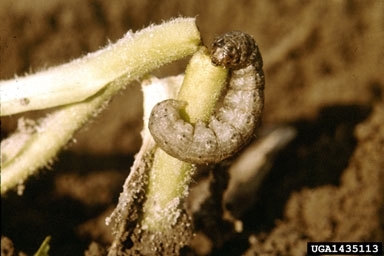Cutworms
Cutworms are the larvae (caterpillars) of several species of night-flying moths in the family Noctuidae. The larvae are called cutworms because they cut down young plants as they feed on stems at or below the soil surface. Cutworms such as the variegated cutworm and black cutworm can be serious pests of young plants. Adults and larvae are nocturnal and hide during the day but may become active during cloudy days. Some cutworms may climb up the plant and feed on unopened buds. If disturbed, the larvae may curl into a C-shaped ball. These dull colored, smooth caterpillars may become up to 1 3/4" long when fully grown.

Clemson University-USDA Cooperative Extension Slide Series, Bugwood.org
Scouting
Visually inspect plants when adults are active. Pay close attention to plants near weedy areas or near vegetable fields. Caterpillars have five or fewer pairs of prologs (fleshy protrusions seen on the abdomen) and hooks (crochets) at the tip of the prolegs that help them attach to the plant. (Sawflies have six or more pair of prologs and the adults are thick-waisted members of the bee family). It is important to distinguish between caterpillars and sawflies because management strategies differ.
Management
Cultural Controls
- Eliminate weeds that may serve as alternate hosts.
- Clean up plant debris which may harbor overwintering pupae.
- Install insect screening to prevent entry of adults into the greenhouses.
- Barriers several inches high can be made by wrapping paper, aluminum foil, thin cardboard, or similar materials around the base of transplant stems.
Biological Controls
The commercially available egg parasitoid, Trichogramma spp. lay their lay their eggs into the eggs of caterpillar pests such as the diamondback moth, cabbage looper and imported cabbageworms. These mini-wasps have a rapid life cycle of about 7 to 10 days from egg to adult, so populations can increase rapidly. Timing is critical as these very small wasps approximately 1/25 of an inch long or less only work against the egg stage and not the larval stage. Trichogramma turns the eggs of some caterpillars black. When releasing these mini-wasps, protect them from ants.
Microbial Controls
Bacillus thuringiensis spp. kurstaki, BTK, applied to the foliage as a spray, is most effective against the young actively feeding larvae. This bacterium must be consumed by the caterpillars in order to be effective, so thorough spray coverage is needed. Repeated applications are also needed, because the bacterium is susceptible to ultraviolet light degradation and may be washed off the leaves. When spraying plants with waxy leaves, such as ornamental kale and cabbage, add a spreader sticker (as long as the label permits this).
Despite good cultural practices, pests and diseases at times may appear. Chemical control should be used only after all other methods have failed. For pesticide information please call UConn Home and Garden Education Center or your local cooperative extension office.
The UConn Home & Garden Education Center supports UConn Extension’s mission by providing answers you can trust with research-based information and resources. For gardening questions, contact us toll-free at (877) 486-6271, visit our website at homegarden.cahnr.uconn.edu, or reach out to your local UConn Extension center at cahnr.uconn.edu/extension/locations.
Revised by the UConn Home and Garden Education Center, 2016.